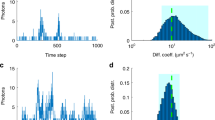Abstract
A fluorescence correlation experiment for measurement of rotational diffusion in the nanosecond time scale is described. Using this method, the rotational diffusion coefficient of bovine carbonic anhydrase B labelled with tetramethylrhodamine isothiocyanate was estimated to be D r=(1.14±0.15)×107 s-1 at 22°C. The experiment is based on a cw argon ion laser, a microfluorimeter with local solution flow inside the sample cell, and two photon detectors. The fluorescence intensity autocorrelation function in the nanosecond time range is computed with the help of a time-to-amplitude converter and a multichannel pulse-amplitude analyser.
Similar content being viewed by others
References
Aragon SR, Pecora R (1975) Fluorescence correlation spectroscopy and Brownian rotational diffusion. Biopolymers 14: 119–138
Aragon SR, Pecora R (1976) Fluorescence correlation spectroscopy as a probe of molecular dynamics. J Chem Phys 64: 1791–1803
Ehrenberg M, Rigler R (1974) Rotational brownian motion and fluorescence intensity fluctuations. Chem Phys 4: 390–401
Fahey PF, Koppel DE, Barak LS, Wolf DE, Elson EL, Webb WW (1977) Lateral diffusion in planar lipid bilayers. Science 195: 305–306
Kask P, Piksarv P, Mets Ü (1985) Fluorescence correlation spectroscopy in the nanosecond time range: photon antibunching in dye fluorescence. Eur Biophys J 12: 163–166
Koppel D (1974) Statistical accuracy in fluorescence correlation spectroscopy. Phys Rev A 10: 1938–1945
Lippmaa ET, Olivson AI, Jarvet JI-H, Aguraiuja RK (1983) Study on bovine carbonic anhydrase B by [13C] NMR spectroscopy. Mol Biol (U.S.S.R.) 17: 484–491
Magde D, Elson E, Webb WW (1972) Thermodynamic fluctuations in a reacting system — measurement by fluorescence correlation spectroscopy. Phys Rev Lett 29: 704–708
Magde D, Elson EL, Webb WW (1974) Fluorescence correlation spectroscopy. II. An experimental realization. Biopolymers 13: 29–61
Magde D, Webb WW, Elson EL (1978) Fluorescence correlation spectroscopy. III. Uniform translation and laminar flow. Biopolymers 17: 361–376
Rigler R, Grasselli P, Ehrenberg M (1979) Fluorescence correlation spectroscopy and application to the study of brownian motion of biopolymers. Phys Scr 19: 486–490
Sirk A, Kask P, Kändler T, Karu T, Puskar J, Lippmaa E (1979) Clip-correlator for fluorescence correlation experiments. Proc Acad Sci Estonian SSR Phys Math 28: 227–232
Sorscher SM, Bartholomew JC, Klein MP (1980) The use of fluorescence correlation spectroscopy to probe chromatin in the cell nucleus. Biochim Biophys Acta 610: 28–46
Yguerabide J, Epstein HF, Stryer L (1970) Segmental flexibility in an antibody molecule. J Mol Biol 51: 573–590
Author information
Authors and Affiliations
Rights and permissions
About this article
Cite this article
Kask, P., Piksarv, P., Mets, Ü. et al. Fluorescence correlation spectroscopy in the nanosecond time range: rotational diffusion of bovine carbonic anhydrase B. Eur Biophys J 14, 257–261 (1987). https://doi.org/10.1007/BF00256359
Received:
Accepted:
Issue Date:
DOI: https://doi.org/10.1007/BF00256359




